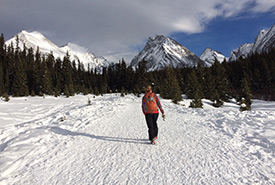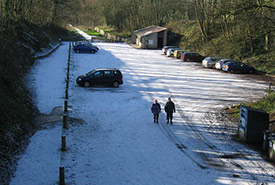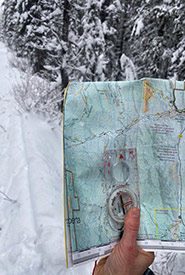8 tips for enjoying your winter experience safely

Spike hike on a relatively warm winter day. (Photo courtesy of Gayle Roodman/NCC staff)
Spending time in nature on a regular basis allows you to observe the subtle changes that happen daily. However, between seasons, the changes aren’t so subtle. In winter, low temperatures and shorter days force species to adapt. Deciduous trees shed their leaves, many bird species migrate to warmer places, some mammals change colour to better camouflage in a snowy environment and others prefer to go to “sleep” to conserve their energy.
When visiting nature in winter, we, too, need to adapt to remain safe and to truly enjoy the experience. Apply these eight tips, taking into account the remoteness and duration of you planned visit, to enjoy your winter experience safely:
1. Check for hazards at your destination
Check whether the trail is in an area of avalanche risk. If you’re going to cross a lake, check with local authorities and websites about whether it’s safe to be on the ice.
2. Check the weather forecast
Pay close attention to the weather forecast until you venture into nature and, if possible, check the forecast periodically during your visit, especially if you plan to stay longer than a couple of hours. Be prepared to change your plans if the conditions aren’t favourable or if they worsen. Make sure you stay on marked trails to avoid being disoriented. If you are worried about getting lost, for example by falling snow obscuring the trail, mark your way with flagging tape as required (remove it on your way out).
3. Leave your vehicle in plain sight

Car parked in a visible spot at trail head (Photo by Wikimedia Commons)
Park your vehicle in plain sight, where it will be noticed if your experience takes longer than expected. If you leave for an extended period of time, leave a message on the dashboard stating your route.
4. Adopt the nature dress code
Dress like an onion (in multiple layers) so you can adapt to the changing weather conditions. Make sure to include an impermeable layer, and bring spare socks and mittens in case they get wet. Make sure you wear the appropriate footwear for the terrain and weather conditions, such as having proper grip for icy paths.
5. Bring food, drinks and other goodies
Bring water as well as high-energy food and beverages. Carry basic winter survival supplies such as a knife, matches, flashlight, reflective blanket, flagging tape and a whistle. Pack everything so it is protected from the elements.
6. Prepare for your visit

A topographic map and a compass (Photo by Gayle Roodman/NCC staff)
Bring a printed map of the area you plan to explore and a compass. Don’t rely on electronics (GPS, cellphone, radio, etc.) as cold weather can severely impact battery life. Choose equipment (skis, snowshoes, etc.) that is best suited for the area you are planning to explore. Remember that daylight hours are shorter in winter, so take that into consideration.
7. Let someone know where you are
Let someone know where you’re going and when you’re planning to return. And don’t forget to let them know when you’re back!
8. Share your experience
Bring someone along on your adventure. Outdoor experiences are always safer when you’re not alone.


